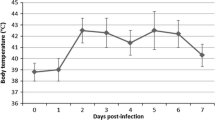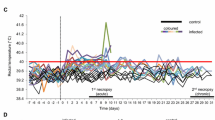Abstract
Post-weaning multisystemic wasting syndrome (PMWS) is a relevant, worldwide disease caused by porcine circovirus type 2 (PCV2). Microscopically, PMWS is mainly characterized by lymphocytic depletion, macrophage infiltration and syncytia in lymphoid tissues. Some data suggest that follicular dendritic cells (FDCs) could be infected by PCV2, thus likely playing a role in the pathogenesis of PMWS. The present paper aims at assessing, qualitatively and quantitatively, the FDCs’ network in the soft palate tonsils of clinically healthy and PMWS-affected pigs. Consecutive tissue sections were tested by immunohistochemistry to detect PCV2, FDCs and macrophages. FDCs and PCV2 antigens were quantitatively assessed by means of the Image J software and results submitted to statistical analysis. Our data demonstrated that FDCs are significantly reduced in PMWS-affected pigs compared with healthy pigs and that FDCs’ depletion should be considered among microscopic features of PMWS. It is reasonable to hypothesize that depletion of FDCs further compromises the immune response and enhances the occurrence and the severity of secondary infections, which are relevant for the clinical manifestation of PMWS.






Similar content being viewed by others
References
Harding JC, Clark EG, Strokappe JH, Wilson PI, Ellis JA (1998) Post-weaning multisystemic wasting syndrome (PMWS): epidemiology and clinical presentation. J Swine Health Prod 6:249–254
Rose N, Opriessnig T, Grasland B, Jestin A (2012) Epidemiology and transmission of porcine circovirus type 2 (PCV2). Virus Res 164:78–89
Kennedy S, Moffett D, McNeilly F, Meehan B, Ellis J, Krakowka S, Allan GM (2000) Reproduction of lesions of postweaning multisystemic wasting syndrome by infection of conventional pigs with porcine circovirus type 2 alone or in combination with porcine parvovirus. J Comp Pathol 122:9–24
Opriessnig T, Halbur PG (2012) Concurrent infections are important for expression of porcine circovirus associated disease. Virus Res 164:20–32
Segalés J (2012) Porcine circovirus type 2 (PCV2) infections: clinical signs, pathology and laboratory diagnosis. Virus Res 164:10–19
Anonymous (2015) International Committee on Taxonomy of Viruses. ICTV Taxonomy History for Porcine circovirus 2. http://www.ictvonline.org/virustaxonomy.asp. Accessed 2 November 2016
Opriessnig T, Langohr I (2013) Current state of knowledge on porcine circovirus type 2-associated lesions. Vet Pathol 50:23–38
Huang YY, Walther I, Martinson SA, López A, Yason C, Godson DL, Clark EG, Simko E (2008) Porcine circovirus 2 inclusion bodies in pulmonary and renal epithelial cells. Vet Pathol 45:640–644
Chianini F, Majò N, Segalés J, Domìnguez J, Domingo M (2003) Immunohistochemical characterization of PCV2 associate lesions in lymphoid and non-lymphoid tissues of pigs with natural postweaning multisystemic wasting syndrome (PMWS). Vet Immunol Immunopathol 94:63–75
Gilpin DF, McCullough K, Meehan BM, McNeilly F, McNair I, Stevenson LS, Foster JC, Ellis JA, Krakowka S, Adair BM, Allan GM (2003) In vitro studies on the infection and replication of porcine circovirus type 2 in cells of the porcine immune system. Vet Immunol Immunopathol 94:149–161
Hansen MS, Pors SE, Bille-Hansen V, Kjerulff SK, Nielsen OL (2010) Occurrence and tissue distribution of porcine circovirus type 2 identified by immunohistochemistry in Danish finishing pigs at slaughter. J Comp Pathol 142:109–121
Tsai YC, Jeng CR, Hsiao SH, Chang HW, Liu JJ, Chang CC, Lin CM, Chia MY, Pang VF (2010) Porcine circovirus type 2 (PCV2) induces cell proliferation, fusion, and chemokine expression in swine monocytic cells in vitro. Vet Res 41:60
Mandrioli L, Sarli G, Panarese S, Baldoni S, Marcato PS (2004) Apoptosis and proliferative activity in lymph node reaction in postweaning multisystemic wasting syndrome (PMWS). Vet Immunol Immunopathol 97:25–37
Resendes AR, Majó N, Segalés J, Mateu E, Calsamiglia M, Domingo M (2004) Apoptosis in lymphoid organs of pigs naturally infected by porcine circovirus type 2. J Gen Virol 85:2837–2844
Lin CM, Jeng CR, Hsiao SH, Liu JP, Chang CC, Chiou MT, Tsai YC, Chia MY, Pang VF (2011) Immunopathological characterization of porcine circovirus type 2 infection-associated follicular changes in inguinal lymph nodes using high-throughput tissue microarray. Vet Microbiol 149:72–84
Rosell C, Segalés J, Ramos-Vara JA, Folch JM, Rodríguez-Arrioja GM, Duran CO, Balasch M, Plana-Durán J, Domingo M (2000) Identification of porcine circovirus in tissues of pigs with porcine dermatitis and nephropathy syndrome. Vet Rec 146:40–43
Krakowka S, Ellis JA, McNeilly F, Gilpin D, Meehan B, McCullough K, Allan G (2002) Immunologic features of porcine circovirus type 2 infection. Viral Immunol 15:567–582
Krautler NJ, Kana V, Kranich J, Tian Y, Perera D, Lemm D, Schwarz P, Armulik A, Browning JL, Tallquist M, Buch T, Oliveira-Martins JB, Zhu C, Hermann M, Wagner U, Brink R, Heikenwalder M, Aguzzi A (2012) Follicular dendritic cells emerge from ubiquitous perivascular precursors. Cell 150:194–206
El Shikh ME, Pitzalis C (2012) Follicular dendritic cells in health and disease. Front Immunol 3:292
Aguzzi A, Kranich J, Krautler NJ (2014) Follicular dendritic cells: origin, phenotype, and function in health and disease. Trends Immunol 35:105–113
Mabbott NA, MacPherson GG (2006) Prions and their lethal journey to the brain. Nat Rev Microbiol 4:201–211
Nuvolone M, Aguzzi A, Heikenwalder M (2009) Cells and prions: a license to replicate. FEBS Lett 583:2674–2684
Maestrale C, Di Guardo G, Cancedda MG, Marruchella G, Masia M, Sechi S, Macciocu S, Santucciu C, Petruzzi M, Ligios C (2013) A lympho-follicular microenvironment is required for pathological prion protein deposition in chronically inflamed tissues from scrapie-affected sheep. PLoS One 8(5):e62830
Zhang J, Perelson AS (2013) Contribution of follicular dendritic cells to persistent HIV viremia. J Virol 87:7893–7901
Ellis J, Krakowka S, Lairmore M, Haines D, Bratanich A, Clark E, Allan G, Konoby C, Hassard L, Meehan B, Martin K, Harding J, Kennedy S, McNeilly F (1999) Reproduction of lesions of postweaning multisystemic wasting syndrome in gnotobiotic piglets. J Vet Diagn Inves 11:3–14
Guarino H, Goyal SM, Murtaugh MP, Morrison RB, Kapur V (1999) Detection of porcine reproductive and respiratory syndrome virus by reverse transcription-polymerase chain reaction using different regions of the viral genome. J Vet Diagn Invest 11:27–33
Resendes AR, Majó N, Segalés J, Espadamala J, Mateu E, Chianini F, Nofrarías M, Domingo M (2004) Apoptosis in normal lymphoid organs from healthy normal, conventional pigs at different ages detected by TUNEL and cleaved caspase-3 immunohistochemistry in paraffin-embedded tissues. Vet Immunol Immunopathol 99:203–213
Wilson S, Norton P, Haverson K, Leigh J, Bailey M (2005) Development of the palatine tonsil in conventional and germ-free piglets. Dev Comp Immunol 29:977–987
Cook RW (1996) Oral cavity. In: Sims LD, Glastonbury JRW (eds) Pathology of the pig. A diagnostic guide. The Pig Research and Development Corporation, Barton, pp 29–40
Bacci B, Brunetti B, Panarese S, Mandrioli L, Sarli G, Ostanello F, Caprioli A, Cerati C, Marcato PS (2006) Ricerca di PCV2 in linfonodi sottomascellari in 170 suini regolarmente macellati nel nord Italia. In: The Proceedings of the 2006 SIPAS Annual Meeting pp 291–296
Grouard G, Durand I, Filgueira L, Banchereau J, Liu YJ (1996) Dendritic cells capable of stimulating T cells in germinal centres. Nature 384:364–367
Vincent IE, Carrasco CP, Herrmann B, Meehan BM, Allan GM, Summerfield A, McCullough KC (2003) Dendritic cells harbor infectious porcine circovirus type 2 in the absence of apparent cell modulation or replication of the virus. J Virol 77:13288–13300
Vincent IE, Carrasco CP, Guzylack-Piriou L, Herrmann B, McNeilly F, Allan GM, Summerfield A, McCullough KC (2005) Subset-dependent modulation of dendritic cell activity by circovirus type 2. Immunology 115:388–398
Sarli G, Mandrioli L, Laurenti M, Sidoli L, Cerati C, Rolla G, Marcato PS (2001) Immunohistochemical characterisation of the lymph node reaction in pig post-weaning multisystemic wasting syndrome (PMWS). Vet Immunol Immunopathol 83:53–67
Tomás A, Fernandes LT, Valero O, Segalés J (2008) A meta-analysis on experimental infections with porcine circovirus type 2 (PCV2). Vet Microbiol 132(3–4):260–273
Yu S, Opriessnig T, Kitikoon P, Nilubol D, Halbur PG, Thacker E (2007) Porcine circovirus type 2 (PCV2) distribution and replication in tissues and immune cells in early infected pigs. Vet Immunol Immunopathol 115:261–272
Katakai T, Hara T, Lee JH, Gonda H, Sugai M, Shimizu A (2004) A novel reticular stromal structure in lymph node cortex: an immuno-platform for interactions among dendritic cells, T cells and B cells. Int Immunol 16:1133–1142
Turley SJ, Fletcher AL, Elpek KG (2010) The stromal and haematopoietic antigen-presenting cells that reside in secondary lymphoid organs. Nat Rev Immunol 10:813–825
Katakai T (2012) Marginal reticular cells: a stromal subset directly descended from the lymphoid tissue organizer. Front Immunol 3:200
Chai Q, Onder L, Scandella E, Gil-Cruz C, Perez-Shibayama C, Cupovic J, Danuser R, Sparwasser T, Luther SA, Thiel V, Rülicke T, Stein JV, Hehlgans T, Ludewig B (2013) Maturation of lymph node fibroblastic reticular cells from myofibroblastic precursors is critical for antiviral immunity. Immunity 38:1013–1024
Fletcher AL, Acton SE, Knoblich K (2015) Lymph node fibroblastic reticular cells in health and disease. Nat Rev Immunol 15:350–361
Do Campo MJ, Cabrera J, Segalés J, Bassols A (2014) Immunohistochemical investigation of extracellular matrix components in the lymphoid organs of healthy pigs and pigs with systemic disease caused by circovirus type 2. J Comp Pathol 151:1–9
Melzi E, Caporale M, Rocchi M, Martín V, Gamino V, Di Provvido A, Marruchella G, Entrican G, Sevilla N, Palmarini M (2016) Follicular dendritic cell disruption as a novel mechanism of virus-induced immunosuppression. PNAS 113:E6238–E6247
Author information
Authors and Affiliations
Corresponding author
Ethics declarations
Conflict of interest
The authors declare no conflicts of interest. All authors contributed to this work and agreed to its publication.
Ethical approval
The present study only included animals who died spontaneously and were slaughtered in compliance with local rules. Pigs were slaughtered according with the European legislation about animal welfare at the abattoir (Council Regulation No 1099/2009).
Electronic supplementary material
Below is the link to the electronic supplementary material.
Rights and permissions
About this article
Cite this article
Marruchella, G., Valbonetti, L., Bernabò, N. et al. Depletion of follicular dendritic cells in tonsils collected from PMWS-affected pigs. Arch Virol 162, 1281–1287 (2017). https://doi.org/10.1007/s00705-017-3244-1
Received:
Accepted:
Published:
Issue Date:
DOI: https://doi.org/10.1007/s00705-017-3244-1




